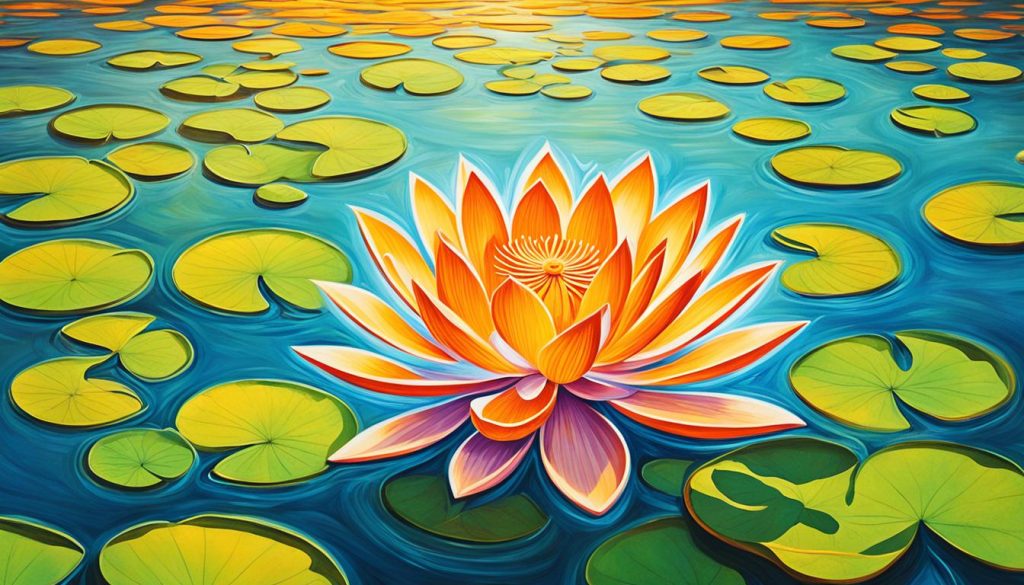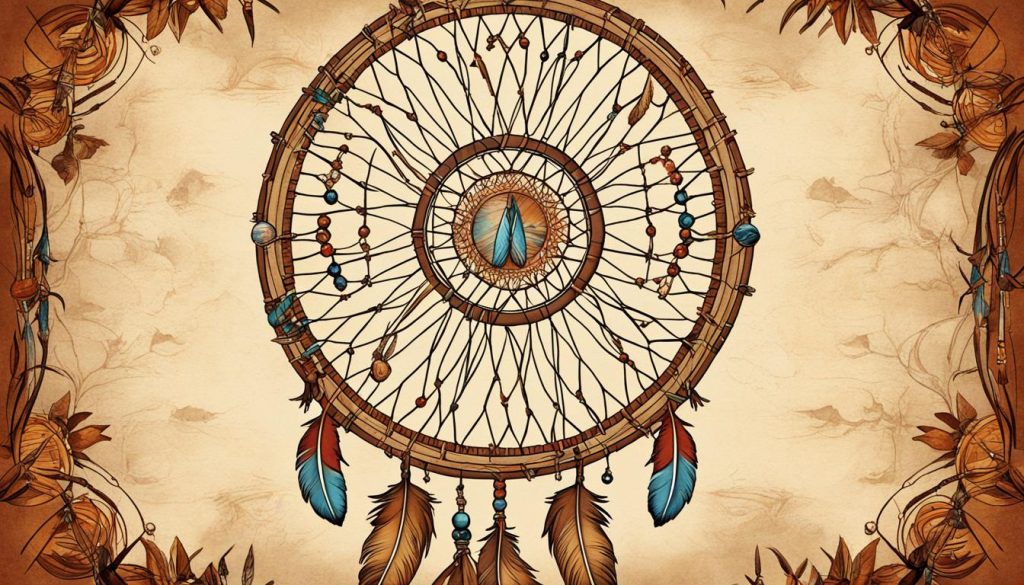Have you ever wondered about the hidden meanings behind the sacred symbols and imagery in Hinduism? Delving into the intricate world of Indian spiritual symbols, we uncover the ancient meanings and divine representations that have shaped religious traditions for centuries.
From the powerful symbol of “Om” to the auspicious Swastika and the significant color saffron, these spiritual icons carry deep symbolism that transcends time and sparks contemplation. Join me on this enlightening journey as we unravel the secrets behind these sacred signs and challenge our understanding of Hindu symbolism.
Key Takeaways:
- Indian spiritual symbols hold ancient meanings and represent divine concepts in Hinduism.
- The sacred syllable “Om” signifies the Absolute and is used in prayers and invocations.
- The Swastika symbolizes the eternal nature of the Brahman, despite its controversial association in modern history.
- The color saffron reflects the Supreme Being and holds deep religious significance in Hinduism.
- Exploring these symbols gives us insight into the rich spiritual traditions of India and challenges our perceptions.
The Power of Om in Hinduism
In Hinduism, the symbol “Om” holds immense significance as the embodiment of divine power and authority. Made up of three Sanskrit letters, Om is used in every prayer and invocation. It represents the Brahman, the ultimate reality from which all existence emerges. Om symbolizes the divinity and the source of all creation.
The sacred syllable Om is not limited to Hinduism alone. It finds similarities in various cultures and languages. For instance, it bears resemblance to the Latin letter “M” and the Greek letter “Omega.” This universal association further emphasizes its profound meaning and universal significance.
The power of Om can also be seen in the English language, where words like “omniscience,” “omnipotent,” and “omnipresent” share similar connotations. These words reflect the all-knowing, all-powerful, and ever-present nature of the divine that Om symbolizes.
Om encompasses the vastness and limitless nature of existence, while also embracing the essence of divinity and spiritual authority.
Om is often chanted during meditation and spiritual practices to invoke a deeper connection with the divine and to attain spiritual harmony. It is considered a sacred syllable that encompasses the entire range of human consciousness, from the physical to the spiritual.
The significance of Om:
- Represents the Brahman or the Absolute
- Symbolizes divinity and spiritual authority
- Invokes a profound connection to the divine
- Reflects the all-knowing, all-powerful, and ever-present nature of the divine
| Symbol | Meaning |
|---|---|
| Om | The sacred syllable representing the Brahman or the Absolute, divinity, and spiritual authority. |
The Sacred Swastika in Hinduism
The Swastika is another important symbol in Hinduism, symbolizing the eternal nature of the Brahman and the omnipresence of the Absolute. Although its resemblance to the Nazi emblem has caused confusion, the Swastika holds great significance in Hindu religious and cultural practices.
The Swastika is a pictorial character shaped like a cross with branches bent at right angles. The term “Swastika” means “May Good Prevail” and has been considered sacred for its protective power, representing auspiciousness and positive energy.
Used in religious celebrations and festivals, the Swastika serves as a reminder to Hindus of the eternal presence of the Divine. It is an auspicious symbol that embodies the everlasting presence and blessings of the Supreme Being.
The Swastika’s significance lies in its representation of the eternal nature of the Brahman, the ultimate reality in Hinduism. It symbolizes the cyclical nature of the universe, encompassing birth, life, and rebirth.
Through the Swastika, Hindus recognize the omnipresence of the Absolute, the presence of the Divine in every aspect of existence. It serves as a constant reminder that the Divine is always with us, guiding and protecting us on our spiritual journey.
The Significance of Saffron in Hinduism
Hinduism encompasses a rich tapestry of symbolism, where each color holds deep religious significance. Among these colors, saffron stands out for its representation of fire and its reflection of the Supreme Being. Fire holds immense importance in Hindu rituals and worship, with its origins dating back to the Vedic age.
Fire altars, known as Agni, serve as powerful symbols of ancient Vedic rites. They are believed to connect the physical and the spiritual worlds, acting as conduits for divine energy. The flames that dance upon these altars embody the sacred essence and transformative power of fire.
Saffron, with its vibrant hue, evokes the warmth and radiance of fire. This color is not only revered by Hindus but also by Sikhs, Buddhists, and Jains. Saffron flags flutter atop temples, signifying the divinity within. It is also worn by Buddhist monks and Hindu saints, symbolizing their renunciation of material desires and their dedication to spiritual pursuits.
The significance of saffron extends beyond its visual representation. It serves as a reminder of the eternal flame that burns within every individual, representing the divine spark of consciousness. Just as fire purifies and transforms, saffron signifies the purification of one’s thoughts, emotions, and actions, leading to spiritual enlightenment.
Through the mesmerizing hue of saffron, Hinduism vividly captures the essence of fire’s religious significance. It encourages adherents to embrace the transformative power within themselves and to strive for spiritual liberation.

| Symbol | Religious Significance |
|---|---|
| Agni | Represents fire and acts as a conduit for divine energy |
| Saffron Flags | Symbolize divinity and flutter atop temples |
| Buddhist Monks and Hindu Saints | Wear saffron as a symbol of renunciation and dedication to spiritual pursuits |
| Transformation | Signifies the purification of thoughts, emotions, and actions leading to spiritual enlightenment |
Exploring Native American Sacred Symbols
Native American culture is rich with intricate and profound symbolism. Sacred symbols in Native American traditions hold deep spiritual significance and convey profound wisdom. These symbols have been passed down through generations, carrying the collective wisdom and interconnectedness with all aspects of life.
One of the most well-known Native American symbols is the Medicine Wheel. This symbol represents the interconnectedness of all things and teaches the importance of harmony and balance in life. It is a powerful reminder that we are all connected and that our actions have a ripple effect on the world around us.
Another significant symbol is the Thunderbird, a legendary creature in Native American mythology. The Thunderbird symbolizes power, strength, and transformation. It is often depicted as a protector against adversity and a bringer of change. The Thunderbird reminds us of our ability to overcome challenges and transform ourselves.
“The Thunderbird is a symbol of power and transformation. It represents the strength within us to rise above challenges and embrace change.”
The Dreamcatcher is another sacred symbol with deep meaning in Native American cultures. It is believed to filter out negative dreams and catch only the positive ones. The Dreamcatcher embodies protection, wisdom, and the power of dreams. Hanging a Dreamcatcher above your bed is believed to bring peaceful and positive dreams, guiding you on your spiritual journey.
Native American spiritual symbols carry profound wisdom and offer insights into the interconnectedness of all living beings. They remind us of our capacity for transformation and the importance of living in harmony with nature and ourselves. These symbols serve as powerful reminders of the spiritual heritage of Native American cultures and invite us to embrace their timeless wisdom.

| Symbol | Meaning |
|---|---|
| Medicine Wheel | Represents interconnectedness, harmony, and balance |
| Thunderbird | Symbolizes power, strength, and transformation |
| Dreamcatcher | Filters out negative dreams and embodies protection and wisdom |
Symbolism in Hinduism
Symbolism plays a significant role in Hinduism, with various symbols carrying deep spiritual meanings that are rooted in Hindu philosophies, teachings, gods and goddesses, and religious traditions. These symbols hold immense importance in Hindu worship and ritual practices.
In Hinduism, symbols can be categorized into two main types: mudras, which are hand gestures, and murtis, which are icons, statues, and drawings. Mudras, such as the Abhaya Mudra (blessing and protection) and the Anjali Mudra (devotion and greeting), represent different aspects of Hindu deities and convey specific spiritual messages.
Among the most popular Hindu symbols are the lotus, representing purity and enlightenment; the conch, symbolizing the auspicious sound of creation; the trishula (trident), signifying the power and sovereignty of deities like Lord Shiva; the Shiva Linga, representing the divine energy and creative power; and the Nataraja, the cosmic dancer who symbolizes the cycle of creation and destruction.
Each of these symbols holds profound spiritual meaning in Hinduism, reflecting the divine presence, cosmic forces, and interconnectedness of the universe. They serve as reminders of the teachings and principles of Hinduism, allowing devotees to connect with the divine and deepen their spiritual journey.







